Armoured Autocar (1914)
 Dominion of canada - circa 30 built.
Dominion of canada - circa 30 built.
Canada's armor in WW1
Durin the time of the last offensives, the four Canadian infantry Divisions were supported throughout their actions with British and French Tanks, but the idea to raise a Canadian unit only emerged in late 1918. They were seen at first as a simple extension of the existing Machine Gun Corps (1914), creating the additional 1st and 2nd Canadian Tank Battalions and 3e "Bataillon de chars d'assaut" (From Montreal). Only the 1st Canadian Tank Battalion went further than paper only, by obtaining personal and Mark V tanks to start training until finally authorized... two days after the armistice. The first (Armoured) Canadian motorized unit remained the visionnary "Canadian Automobile Machine Gun Brigade" created in 1914 by french-Canadian millionaire Raymond Brutinel. It was also called at the beginning "Brutinel's brigade", and relied on around 30 vehicles.About Autocar
Since there was no impetus for the production of a tank until the very end of the war, notably due to industrial shortcomings and development time for a new tank, it is surprising Canada got any armored vehicle at all so early into the war, especially relying on its own. But so was the "Armoured Autocar". This was a essentially a mobile machine gun nest. It was developed by Major Raymond Brutinel, a Frenchman immigré to Canada and a former Captain in the French Army Reserve, which became a self-made millionaire in Canada. He promoted an idea in 1914 to combine machine guns with mechanical mobility, assuring the Minister of Militia that he could raise with private funds only an armoured car company. Not a standard practice of the time, it was at first declined and after some persuasion acccepted eventually. However to realized his plans, since Vickers machine guns were unavailable at the time, Brutinel ordered instead 20 machine guns to the Colt Company of Hartford in Connecticut. He then contacted the Autocar Company of Ardmore, Pennsylvania, went there and started to look at the most reliable vehicles, settling on a truck chassis which the best reputation, sturdy enough to carry the men, machine gun, and armour at once. Third, when he found the model he needed, he took the train nearby to the Bethlehem Steel Company (also in Pennsylvania) purchasing stocks of 9.5 mm armour plate. He then planned its rail transportation to bring it all to a single assembly site in Canada. The same site where was raised his brigade.Design of the Armoured Autocar
The 1918 design by Frank Saczeany is probably the first ever Canadian "tank" and armoured vehicle designs as a whole, but not one of the first. Indeed, armoured cars were already a thing in the Americas and Europe since 1906, as much as the young automotive industry developed. The "Armoured Autocar" was in the category of armoured lorries, not "cars" in the strict sense, although the vehicle was smaller and lighter than many armoured cars of her time. In particular, contrary to the Charron Model 1905 and the Austrian Austro-Daimler Panzerautomobil, it was only partially armored and had no traversing turret. With its large wooden spoked wheels it was more like an old west wagon with armoured plates and machine guns than the idea of an armoured car.The design was reminiscent of the time, 1914, showing an open top armoured box, with flat sides but an angled front plate. It contained two axial machine guns mounted on pedestals, so they can fire above the sides and against aerial targets if needed. They could be dismounted also to be used by infantry. The complete vehicle, armoured, weighed 3 tons. Its crew comprised 8 men: The driver/mechanic, an officer, four machine guns servants and two riflemen. Its engine ensured a top speed of 40 km/h (25 mph) on flat, which was honorable, but it was never designed for the no-man's land muddy cratered nightmarish landscape of the western front: Its offroad capabilities were very limited, as most armoured cars of the time.
They both had firepower and mobility but their open tops made their crews vulnerable, to snipers, strafing attacks, and shrapnel. The vehicles also were not large enough to accomodate all eight crewmen at once when firing both their MGs. Extra men were carried in trucks. When deployed in combat, three men served the 2 Vickers (Two machine gunners and a single loader) plus the driver and officer. When dismounted, the crew of eight was deplyed, with a gunner also carriying the tripod to the setup position, a belt feeder carrying the gun itelf to the setup position, two men in charge of the ammo boxes, cooling water and spare parts, a scout and runner and a range taker and spare body carrier. They were all trained in all positions and could strip and reassemble the weapon blindfolded. The armoured autocar was sometimes brought forward in extra support, its front facing the enemy lines, and carrying a Lewis Machine Gun mounted in front.
The Canadian Automobile Machine Gun Brigade
On 15 September 1914, the Canadian Automobile Machine Gun Brigade (of the C.E.F.) was created and mobilized. It comprised the 1st and 2nd Sifton Batteries and was commanded by its own creator, Major Brutinel, nine other officers and 124 crewmen. It comprised 8 Armoured Autocars, carryying in all 16 machine guns and four spares, and for support, 8 trucks and 4 automobiles. This was assuredly the first motorized unit in Canada, and one of the first worldwide. In 1915, three more batteries named "Eaton", "Borden" and "Yukon", were created, still with private funding, making for a second unit. These brigades obtained the permission of deployment overseas and were moved in France. However by that time, the fight was now static and there was no place for them in the new kind of warfare of the western front.On 16 May 1915, the units were redesignated 1st and 2nd Canadian Motor Machine Gun Brigades, C.E.F. They were subdivided into the A, B, C, D and E batteries (for both brigades), each having 8 Armoured Autocars and 12 specially designed light trucks. In addition to the riflemen, each Armoured Autocar carried 2 Vickers 0.3 inches (7.92 mm) liquid-cooled machine guns and 20,000 rounds of ammunition. The trucks stored extra ammunition, gasoline and food, enough for 14 men. Each Section in a battery comprised 2 cars, under the command of a Lieutenant, therefore four sections made a Battery, under the command of a Captain. Each brigade organically integrated also a section of motorcycles, 51 scouts which acted as advanced recce, signallers and dispatch riders. Like many armoured cars which stayed on the western front, their career was spent patroling on the rear lines. Nothing much happened, but towards the end of the war, they were more and more deployed as point defence against German aviation.
It's not before the German breakthrough in the spring of 1918 that these Armoured Autocars prove their worth in combat. Brutinel at first wanted them in 1914 to spearhead an advance through enemy lines, but they will excel in defense, "filling holes" in the lines whenever possible, repelling German attacks.
Legacy
Brutinel's Canadian Motor Machine Gun Brigades nevertheless would leave an impressive legacy as the world's first equipped armoured units and their creation would not have been possible without the support of the visionary Minister of Militia, Sam Hughes, which fully saw the concept of firepower combined with mechanical mobility. Brutinel never contacted the military, which was not pleased as a result. The Canadian Armoured Autocar was a powerful influence on later armoured car designs, guiding the creation notably of the M2/M3/M5 Half-Tracks cars units during the Second World War. Although this is not credited directly, the Germans knkew about them ans developed the Panzergrenadiers, morotized infantry carried by the Sd.Kfz 251, or the Russians to creat companies using the BA-30. This was an early influence for modern day reconnaissance units and armoured vehicles and even modern wheeled APCs. It took another 20 years after WWI for these ideas to stick with the British War Office. Today, a single surviving Armoured Autocar found a home at the Canadian War Museum in Ottawa, Ontario (not in running conditions).Read More/Src
On landship forumsOn Google sites
The Armoured_Autocar on wikipedia
The Canadian Automobile Machine Gun Brigade
About Autocar USA
On landships II
On military factory
On cbc.ca
Gallery at the Canadian war museum
See also:
B T White. 1970. Tanks and Other Armoured Fighting Vehicles 1900 - 1918. Blandford Press Ltd, London, England.
C Pulsifer. 2007. The Armoured Autocar In Canadian Service. Service Publications, Ottawa, Canada.
A general history of the CEF in WWI (PDF)
Autocar specifications | |
| Dimensions | 4,90 x 1,75 x 2,3 m (16.1 x 5.9 x 7.6 ft) |
| Total weight, battle ready | 4 tons |
| Crew | 3-6 |
| Propulsion | 4-cyl Gas. Minerva 8L, 40bhp at 2500 rpm |
| Speed | 40 km/h (25 mph) |
| Range | 150 km (90 mi) |
| Armament | 1 x Hotchkiss Model 1909 machine-gun |
| Armour | Maximum 4 mm (0.15 in) |
| Total production | 35 |
Gallery
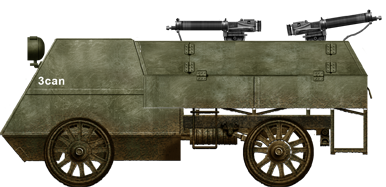
Illustration of the Autocar armoured car, in standard olive green livery. It seems no camouflaged version ever existed from existing photo evidence
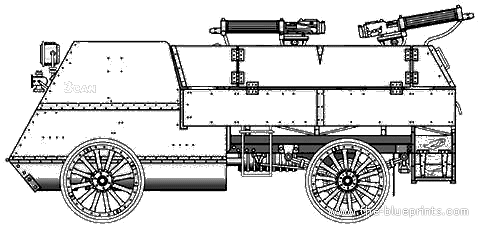
An Autocar Armoured Car
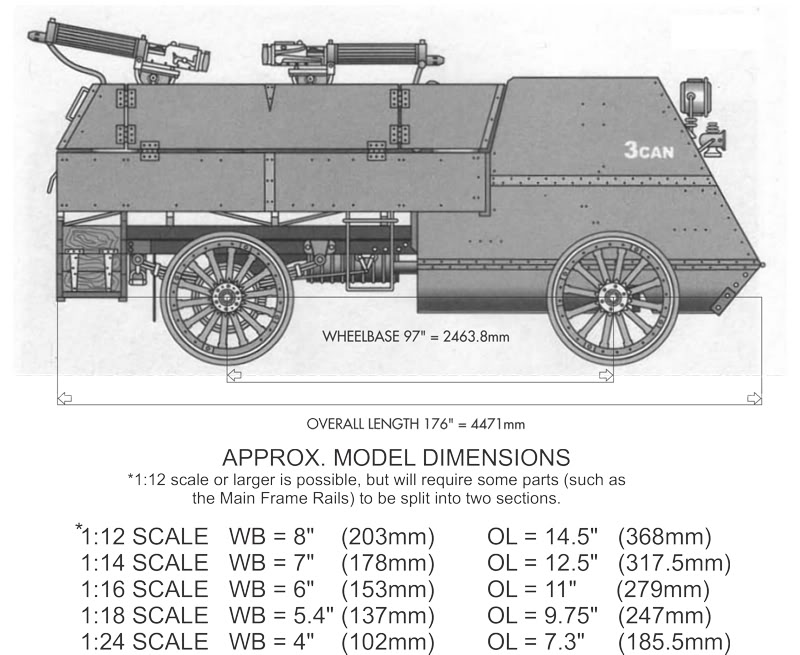
Layout picture of the vehicle
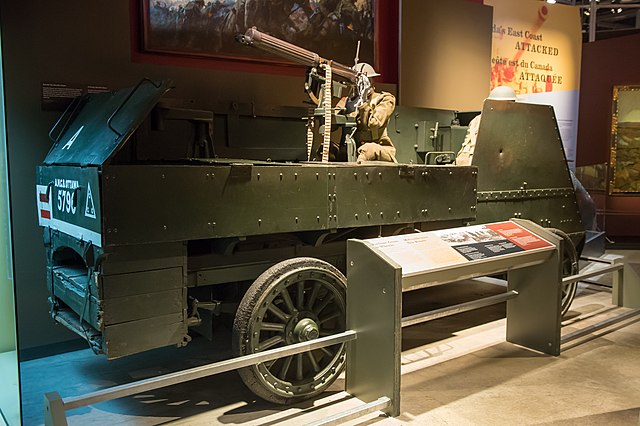
Armoured Machine Gun Carrier Autocar at the Canadian war Museum
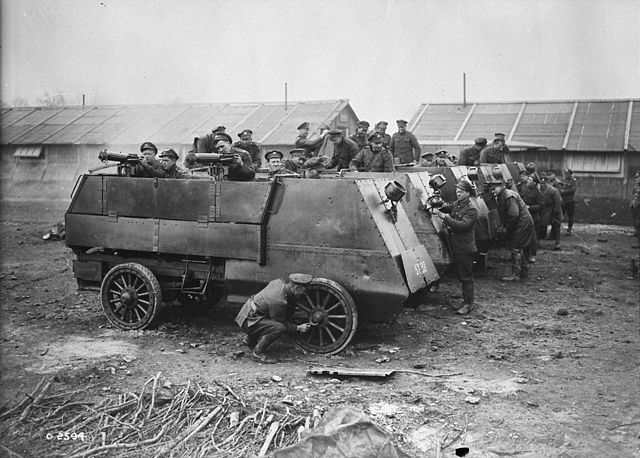
Cleaning armoured cars, Canadian Motor Machine Gun Brigade, April 1918
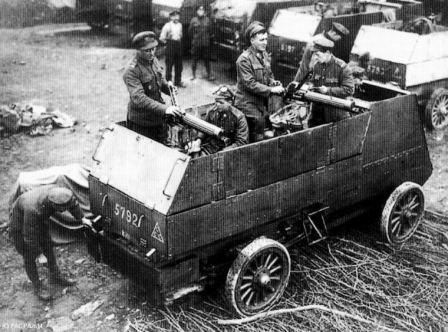
Canadian Armoured Autocar in action
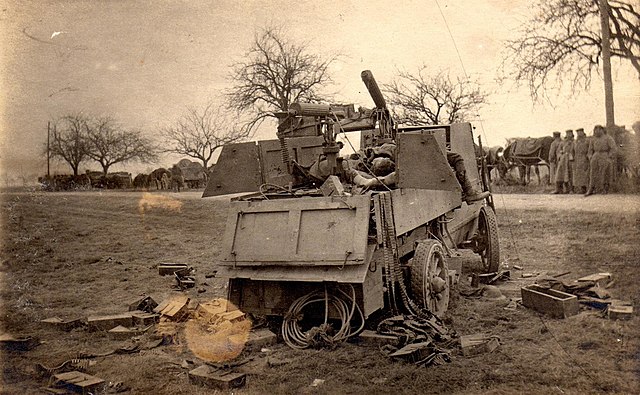
Destroyed Armoured Autocar

The Great War
 Austria-Hungary
Austria-Hungary Belgium
Belgium British Empire
British Empire France
France German Empire
German Empire Italy
Italy Russia
Russia USA
USAWW1 tanks posters
